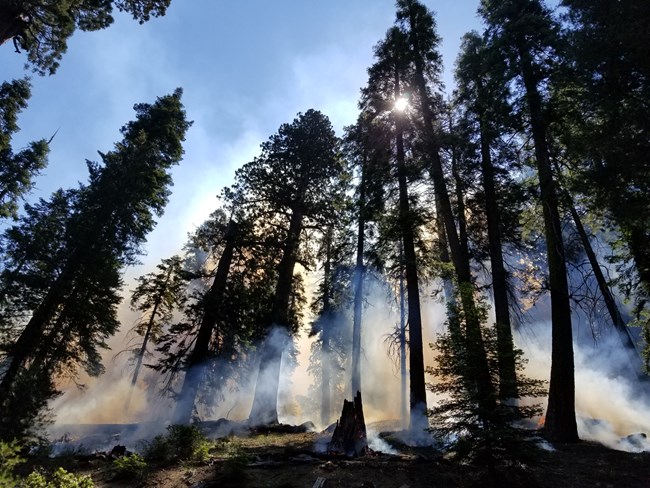|
If you are visiting the parks, be aware that fire and smoke can be present at any time. Portions of the fire-adapted environments of Sequoia & Kings Canyon National Parks burn each year as they have for thousands of years. Depending on your preference, the presence of fire and smoke can be fascinating, disagreeable, or both. 
NPS Photo - M. Theune Ask yourself the following questions:
Am I sensitive to smoke? If you are very sensitive to or bothered by smoke and your destination in the parks has current fire activity, the parks encourage you to visit an alternate location in Sequoia or Kings Canyon where you will be more comfortable. You can still learn about the role of fire from ranger-led programs or visitor center exhibits. For information on current activities, go to News Releases. For information on possible upcoming projects, go to Planned Projects. (Special Note: Aside from smoke, certain summertime weather conditions in these national parks cause unhealthy air quality because of ozone. For more information, visit our Air Quality Information page.) Will I be having a campfire or near one?Most of our campgrounds allow campfires. Emissions from many simultaneous campfires can produce poor air quality on a local scale. This is especially true in the nighttime and early morning hours, when inversions trap and concentrate the smoke from those campfires at ground level. These conditions may affect some individuals, especially those with pre-existing health conditions (e.g. asthma). Reducing Smoke ExposureWhile fire is a very important process for maintaining healthy forest conditions in the Sierra Nevada, there is a challenging side effect: smoke. Fine particles from fire emissions are respiratory irritants and exposure to high concentrations of these fine particulates can cause persistent cough, wheezing and difficulty breathing. While most fires do not cause serious smoke impacts for visitors or residents, it is inevitable that some smoke will be present. Some people are more susceptible than others to smoke but it’s a good idea to avoid breathing smoke if you can help it. If you are in an area that is experiencing a fire, follow the recommendations found at the Environmental Protection Agency's Air Now website. Exposure to this smoke can be reduced through actions by both park management and the public. Fire managers are sensitive to the need for smoke management during fire operations since the parks host nearly 1.5 million visitors each year and share boundaries with numerous local communities. What Park Management DoesSmoke management in the parks consists of at least four different strategies:
What the Public Can DoWith advanced notice, people can follow simple guidelines to reduce their exposure on smoky days:
Consult your physician if, after following these guidelines, you still experience discomfort while breathing. |
Last updated: October 12, 2023
